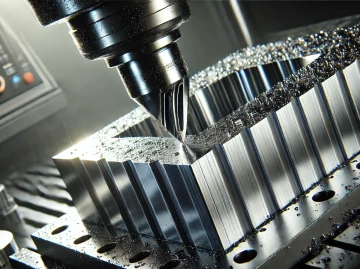Chamfering : Definition, Techniques, and Applications
Publiée le 18.11.2022
What is Chamfering?
Definition of Chamfering
Chamfering is a machining process that involves creating a bevel or an oblique cut on the edge of a piece. This technique helps reduce sharp angles, thereby improving both the aesthetics and safety of the finished piece. Chamfering should not be confused with beveling: a chamfer is a standard angle, generally 45°, while a bevel can have a more variable angle and is often used for specific applications like assembly joints. Thus, the chamfer, often measured in millimeters, offers an effective solution for precise adjustments on screw heads or other assembly elements.
Objectives of Chamfering
Chamfering is essential in many industries for several reasons: - Safety: It reduces sharp edges that could injure operators. - Aesthetics: A chamfer provides a clean and professional finish to the piece. - Preparation for other operations: In machining, chamfering facilitates drilling, cutting, or welding by reducing the formation of chips or burrs. This is particularly useful for materials like steel, aluminum, or plastic.
Different Chamfering Methods
Manual Chamfering
Manual chamfering is often done with simple tools such as files, deburrers, or scrapers. This method is generally used for single pieces or for precise adjustments on-site, where speed is not critical. For example, in plumbing or automotive repair, this method is used to deburr edges after drilling or cutting. Using manual tools for neat chamfering ensures an efficient finish, even in confined spaces.
Mechanical Chamfering
Mechanical chamfering uses machine tools like milling machines or CNC machines to automate the process. This method is ideal for mass production because it is both fast and precise. 45° chamfer mills, double-sided chamfer mills, and multi-purpose mills are commonly used to process various types of materials. The main advantage of mechanical chamfering is its efficiency for large parts or harder materials. However, it requires a more significant initial investment in machines.
Thermal Chamfering
Thermal chamfering uses laser or plasma cutting techniques to create a clean and precise chamfer, even on thick materials. This method is often used in the aerospace industry and metal construction, where precise and rapid cuts are crucial. It also minimizes burrs and thermal distortions. The laser, in particular, allows for high-speed work while maintaining excellent finish quality.
Tools Used for Chamfering
Manual Tools
Manual chamfering tools include files, deburrers, scrapers, and precision knives. These tools are perfect for small interventions or when precision is crucial on limited surfaces. For example, a deburrer effectively cleans the edges of a hole after drilling.
Mechanical Tools
Mechanical tools include milling machines and CNC machines. Mills, like the 1/4 circle concave mill or the multi-purpose mill, are chosen based on the type of material and the thickness of the piece to be worked on. For steel, robust mills are needed, while for softer materials like aluminum, lighter mills suffice. The choice of tool also depends on the chamfer angle and the desired cutting speed.
Reference: 21730, 21735
Chamfering Applications in Various Industries
Chamfering in the Automotive Industry
In the automotive industry, chamfering is commonly used to adjust parts before assembly, reduce accident risks related to sharp edges, and improve vehicle durability. For example, during the manufacturing of engines or bodies, a chamfer optimizes the fit of parts.
Chamfering in Aerospace
Chamfering is crucial in aerospace for preparing parts before welding or assembly. It prevents chatter during welding and ensures better adhesion. This technique is used on delicate parts where precision is essential to ensure flight safety.
Chamfering in Metal Construction
In metal construction, chamfering prepares edges before welding, increasing the efficiency and quality of the welded joint. This preparation also minimizes the risk of cuts for operators and improves the durability of steel or aluminum parts.
Why is Chamfering Important for Product Safety and Quality?
Improving Operator Safety
Chamfering reduces sharp edges and minimizes the risk of cuts for workers. It is a crucial step to enhance safety on production lines.
Optimization of Welding and Assembly Processes
A well-executed chamfer ensures better adhesion for welding, thus reducing defects and improving the final product quality. It also facilitates the assembly of parts, ensuring a precise and durable fit.
Aesthetics and Finishes
Chamfering improves the overall appearance of parts by giving them a cleaner and more professional finish. This attention to detail is particularly important in industries like automotive, where the appearance of visible parts is crucial.
How to Choose the Best Chamfering Method?
Factors to Consider
To choose the best chamfering method, several criteria must be considered: - Type of Material: Different tools and techniques are necessary for steel, aluminum, or plastic. - Required Precision: Manual or mechanical methods can be used depending on the desired level of finish. - Production Volume: For large series, automatic methods are more cost-effective.
Expert Recommendations
Experts recommend opting for an integrated chamfering module in machine tools to improve efficiency. For example, a double-sided chamfer mill is ideal for versatile applications, while a multi-purpose mill offers an adaptable solution for different types of materials and thicknesses.
Conclusion: The Importance of Chamfering in Modern Industry
Chamfering is an important process for ensuring the safety, aesthetics, and quality of parts in many industries. Whether in automotive, aerospace, or metal construction, this technique remains indispensable. For more information or personalized advice, feel free to ask our chamfering experts.



